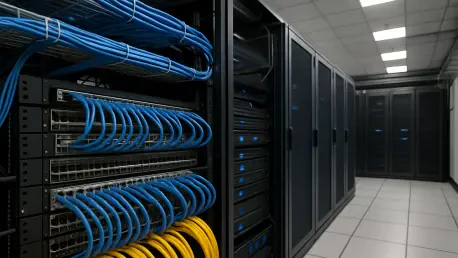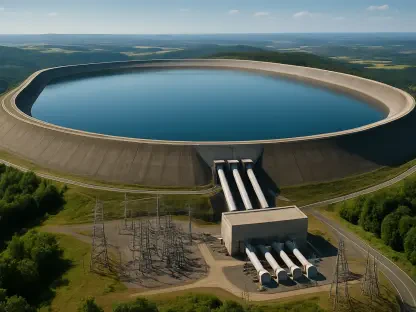Ohio is currently experiencing a technological transformation with the Public Utilities Commission’s approval of new rules governing data center interconnections. The state grapples with fostering the growth of data centers, essential for major technology companies like Google, Amazon, and Microsoft, while safeguarding consumers from potential cost hikes. This balance is crucial as data centers consume massive amounts of electricity to store, manage, and disseminate critical information. The increasing demand has sparked debate among stakeholders, leading to a vital settlement agreement with AEP Ohio. This article delves into the nuances, challenges, and regulatory measures aimed at ensuring equitable growth within Ohio’s energy sector.
Regulatory Shifts and Interconnection Protocols
Historical Demand and Billing Structures
The Ohio Public Utilities Commission’s decision to approve a settlement agreement marks a significant overhaul in the approach to data center growth. By incorporating rules that require specific billing practices, the commission intends to ensure fairness in cost allocation among all electricity users. For data centers with an energy demand of more than 25 megawatts, the new tariff mandates a minimum monthly bill equivalent to at least 85% of their highest historical demand or contract capacity. This structure ensures that even if a data center’s actual usage falls below expectations, the infrastructural costs for maintaining a reliable power supply are covered. This adjustment aligns financial responsibility with potential energy consumption while addressing the high electricity requirements posed by these facilities.
The revised tariffs and associated rules also remove a previously established moratorium on new data center interconnections, a move welcoming the expansion of data centers within the state. Despite this welcoming gesture, the financial obligations imposed aim to prevent infrastructural strains that could impact the general consumer. Such conditions ensure that the true costs of data center operations are transparent and distributed effectively, fostering an environment conducive to both business growth and consumer protection. The necessity for such a balance becomes evident as more high-capacity facilities enter the energy grid.
Financial Assurance and Commitment
A cornerstone of the settlement agreement is the emphasis on financial stability and accountability. Under the new rules, data centers are required to provide evidence of financial viability, alongside collateral, ensuring a robust safeguard against potential defaults on project obligations. These centers, or their financial backers, must become co-signers on interconnection agreements, a measure designed to instill confidence among stakeholders. This move aims to eliminate risks associated with projects that may fail post-initiation or that do not meet operational commitments. Such co-signing reinforces a layer of security, backing the commitment that the data centers will fulfill their interconnection terms.
The financial conditions underscore a significant regulatory understanding that rapid growth should not come at the expense of consumer welfare or grid reliability. The agreement outlines an ambitious yet pragmatic approach to ensure high-stakes investments like data centers do not burden existing ratepayers. This requirement becomes particularly important against the nationwide backdrop of intensifying arguments over how best to integrate these enormous loads into existing infrastructure without destabilizing the financial equilibrium that both consumers and technology firms depend on.
The Impact on Stakeholders and Future Considerations
Addressing Consumer Costs and Grid Stability
One of the pivotal concerns of the Ohio PUC’s decision pertains to managing consumer costs while accommodating substantial data center energy demands. The commission’s strategy involves a meticulous balancing act, focusing on grid stability and cost efficiency. Recognizing that unchecked demand escalation could impose undue financial burdens on other consumers, regulators have imposed stringent rules for compensation. The agreement is designed to safeguard residential and small business ratepayers from cost increases linked to required grid expansions or unanticipated infrastructure demands spawned by new data centers. This approach helps ensure that the interest of the broader community is woven into Ohio’s technological fabric as the industry grows.
Further, Commissioner Dennis Deters stressed the localized nature of this initiative, noting that the conditions are tailored specifically for AEP Ohio’s operational territory. By ensuring the statewide ratepayers’ unique concerns are taken into account, the commission seeks to create a precedent of prudence in the face of industry expansion. With Ohio’s grid being an integral part of a wider network experiencing similar growth challenges, continued attention to both federal and state regulatory measures is paramount. This consideration ensures that consumer protection remains central to the ongoing discourse surrounding the rapid evolution of massive data demands.
Industry Reactions and Future Challenges
The decision by Ohio’s PUC has not gone unchallenged, facing opposition from the Data Center Coalition, a group that counts industry giants like Google, Amazon, and Microsoft among its members. The coalition has expressed its dissatisfaction, pointing out that the approved measures differ significantly from those in other key markets. Criticizing the departure from traditional ratemaking principles, Lucas Fykes, the coalition’s director of energy policy, highlighted the potential ramifications of these measures on future investments in Ohio.
The coalition pledges to meet the full costs of its service requisites while simultaneously voicing concerns that rigorous regulation could deter investment. The coalition argues that if unchecked, stricter regulations might redirect development efforts toward states with more accommodating frameworks. Such dynamics add a layer of complexity to Ohio’s competitive landscape in attracting data center investments, emphasizing the critical need for balanced regulatory frameworks that neither hinder innovation nor imperil consumer welfare. This scenario presents an ongoing challenge for the state as it attempts to shape a digitally forward future in the high-demand environment of data centers.
Navigating Future Growth and Regulatory Prudence
Ohio is undergoing a major technological evolution as the Public Utilities Commission greenlights new protocols for data center interconnections. These changes are part of Ohio’s efforts to propel the development of data centers, which are crucial for tech giants such as Google, Amazon, and Microsoft. However, a significant challenge is ensuring this growth doesn’t unfairly burden consumers with increased costs. Data centers are known for their high electricity demands to store, manage, and distribute vital data, making it imperative to find a balance. The surging need for additional data centers has ignited a spirited debate among interested parties. This discourse led to a key settlement with AEP Ohio, highlighting the importance of collaboration and compromise. The article delves into the subtleties, hurdles, and regulatory strategies designed to guarantee fair growth within Ohio’s energy landscape. Ensuring a fair distribution of responsibility and cost between the tech sector and consumers is vital as Ohio navigates its path forward.









